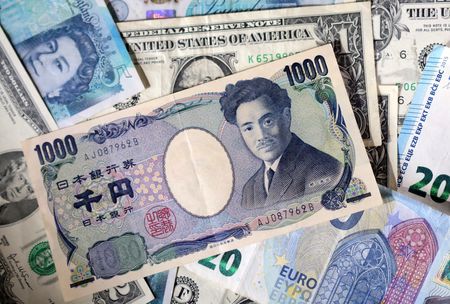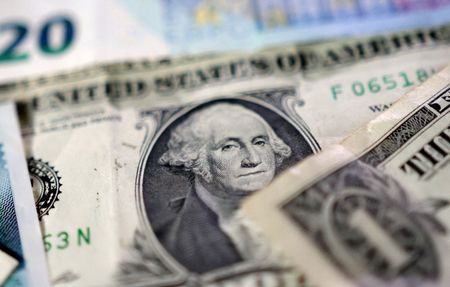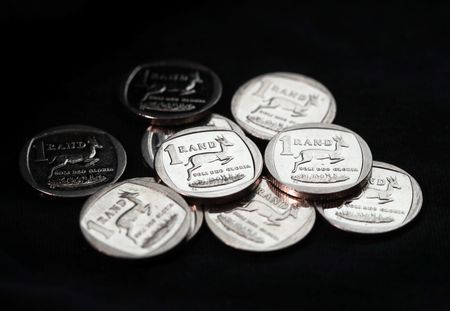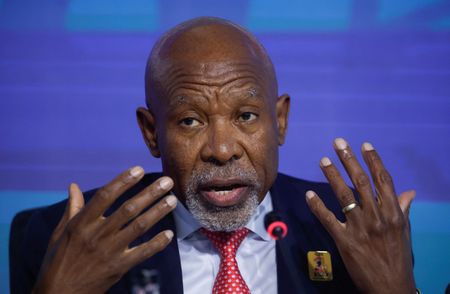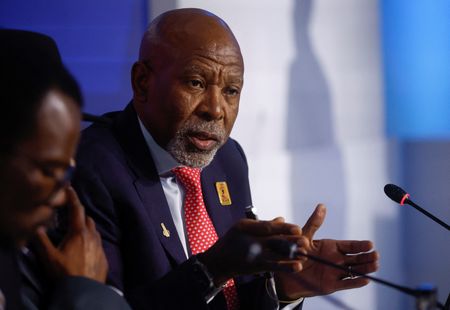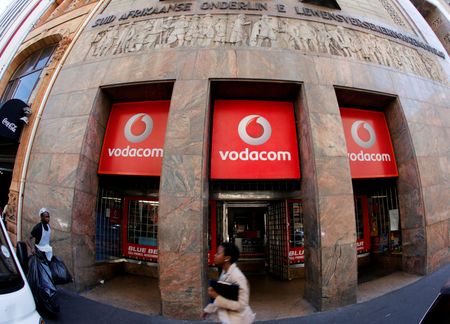By Amanda Cooper and Chibuike Oguh
NEW YORK/LONDON (Reuters) -The U.S. dollar was headed for its first monthly gain for 2025 against major currencies on Thursday, underpinned by easing trade tensions and U.S. economic resilience.
The dollar rose against the yen, trading at its highest level since May 28. It is on track to gain about 5% for July, making it the biggest monthly increase since December 2024. It was last up 0.83% at 150.765.
In a widely expected move, the Bank of Japan on Thursday kept short-term interest rates steady at 0.5% by a unanimous vote, but revised up its inflation forecasts for the next few years.
That came after the Federal Reserve left U.S. interest rates unchanged on Wednesday, ignoring persistent calls by President Donald Trump to lower borrowing costs. Fed Chair Jerome Powell also indicated he was in no rush to cut rates.
The greenback has been bolstered by a hawkish Fed and U.S. economic resilience, with uncertainty over Trump’s chaotic tariffs easing after an array of trade deals.
The dollar index was up 0.16% at 99.949 after rising nearly 1% in the previous session. It is on track for the first monthly gain in 2025.
“There’s been a clash and a friction between what the Fed is seeing and deciding to do, and what the White House and perhaps a lot of people in the equity market want the Fed to do,” said Juan Perez, director of trading of Monex USA in Washington.
“If we had left the hawkish tone, the hawkish stance, and the hawkish press conference altogether, it makes sense to see the U.S. dollar rise – which it did. But today, because of the friction between the Fed and the White House, the dollar is once again hitting the brakes,” Perez added.
Data showed that the number of Americans filing new applications for unemployment benefits increased just marginally last week, suggesting that the U.S. labor market remained stable.
The euro has been one of the biggest casualties of the dollar’s ascent this month, as investors have rushed to unwind bets laid on earlier this year on the premise that the European market may offer better opportunities.
The euro was last up 0.19% at $1.1426, having hit a seven-week low on Wednesday. Still, it remained on track to lose nearly 3% this month.
“I think there was too much optimism in the price of the euro. And I think that’s come back this week. There’s been a lot of commentary about how the EU conceded to the U.S. on this trade deal and that’s been a dose of reality for the Europeans,” Rabobank strategist Jane Foley said.
The dollar weakened 0.31% against the Swiss franc to 0.812 franc but it is on track to gain 2.36% for the month.
The European Union’s agreement on Sunday to 15% tariffs on U.S. exports has cleared up a lot of uncertainty.
BOJ Governor Kazuo Ueda also said the U.S.-Japan trade deal reduced uncertainty on the outlook and heightened the likelihood of Japan durably hitting the BOJ’s 2% inflation target – a prerequisite for further rate hikes.
New U.S. trade deals included one with South Korea, which Trump said on Wednesday would pay a 15% tariff on U.S. imports. That was lower than a threatened 25% and the Korean won strengthened on the news and last stood at 1,395.21 per dollar.
Trump on Wednesday also slapped a 50% tariff on most Brazilian goods and said the United States is still negotiating with India. But he gave Mexico a 90-day reprieve ahead of his Friday deal deadline.
“We do however continue to expect that the tariff rates now being announced and codified will ultimately prove to be more dollar negative, even if some of the bilateral announcements (particularly on the EU) likely catalysed the striking dollar rebound so far this week,” Goldman Sachs analysts led by Stuart Jenkins wrote in an investor note.
(Reporting by Chibuike Oguh in New York; Additional reporting by Rae Wee in Singapore; Editing by Philippa Fletcher, Kirsten Donovan, Susan Fenton and Marguerita Choy)

